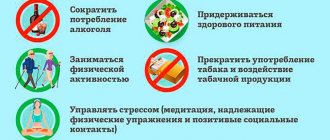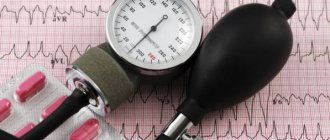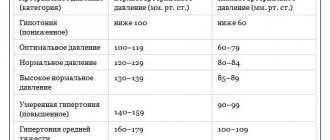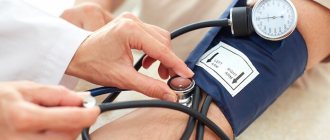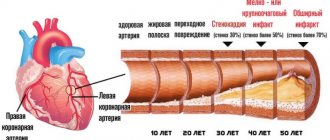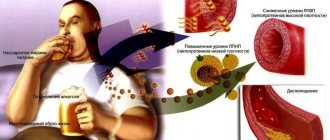A blood pressure of 180/100 is a phenomenon that indicates the presence of hypertension. It may indicate the development of a moderate or even severe degree of hypertensive crisis.
This is a rather dangerous condition that requires immediate correction.
If you don't know what to do if your blood pressure is 180 to 110, be sure to consult your doctor. High systolic blood pressure puts serious stress on the heart.
Knowing what to do if your blood pressure is 130, 180 or higher, you will prevent critical situations.
What does pressure 180 over 100 mean?
It is very important that every patient knows what a pressure value of 180 to 110 means. If you see such numbers on the tonometer, you should immediately call a doctor to provide first aid. They indicate a severe form of hypertension.
Pressure indicators can be deciphered as follows:
- “180” is the amount at which the heart pumps out blood when compressed.
- “100” is the speed at which the heart chambers fill with blood.
High blood pressure itself already poses a danger to humans. If you have a tendency to it, you should regularly consult your doctor.
With a constant upper pressure, the lower one can differ significantly. We recommend studying the following table:
| Arterial pressure | Note |
| 180/60 | May indicate hormonal changes, stress or vegetative-vascular dystonia. |
| 180/70 | Second degree IGAS. |
| 180/80 | Systolic hypertension, impaired venous return, renal or adrenal failure. |
| 180/90 | The first sign of a hypertensive crisis. |
| 180/100 | The third stage of arterial hypertension. |
| 180/110 | Rapid development of hypertension. |
| 180/120 | The presence of a hypertensive crisis, which means a critical situation. |
| 180/130 | Apnea, nervous disorder, the presence of endocrine pathologies, serious kidney or adrenal diseases, hypertension, acromegaly. |
Keep in mind that as your blood pressure increases, your heart rate also increases. Normally, this parameter should not go beyond 60-100 beats per minute.
If a person played sports or was active with other physical activities, then the heart rate may be higher.
Stable 180 to 100
If a person’s blood pressure is constantly 180, then this is a good reason to diagnose “hypertension of the 3rd degree.” This is a serious disease of the cardiovascular system that can even lead to death.
If there are symptoms of this problem, the patient should undergo regular medical examinations to prevent dangerous complications from occurring. Patients usually do not notice this problem.
Only some of them experience a feeling of heaviness, nausea, headaches, and shortness of breath. The absence of signs of pathology significantly complicates treatment.
Different heart rate values
Pressure of 180 over 100 can manifest itself differently in each person. It is very important to determine the heart rate. This indicator reflects the rhythm of the heart.
In addition, the pulse will allow you to determine the possible cause of deviations in health. If you don’t know what to do if your blood pressure is 180 to 90, be sure to call a doctor. You should remember the features of the pulse, namely:
| Heart rate | Note |
| 80 | A normal indicator that reflects the natural activity of the human body. This is slightly higher than normal, but it can be caused by drinking coffee, medications, or playing sports. If the pressure is 180 to 130 and the pulse is like that, you need to call an ambulance. It is noteworthy that some patients may not notice this condition in themselves. |
| 90 | Another indicator that may be normal. In some cases, this is a sign of developing tachycardia, so the patient should undergo diagnostic testing. The heart begins to beat clearly, and there is a feeling of lack of oxygen. |
| 100 | Borderline normal value. It does not indicate pathology if the person has previously played sports or taken certain medications. When a person’s blood pressure is 180 over 70 and such a pulse, shortness of breath, headache, and other signs of malaise occur. |
| 120 | If the pressure has increased to 180 to 120 and the pulse is the same, call an ambulance. This is a clear sign of abnormalities in the functioning of the body. The patient may feel a lack of oxygen, severe headache; there is a loss of consciousness. It is impossible to relieve the condition at home; medical assistance is required. |
If you don’t know what this means (pressure 180 over 80), be sure to consult your doctor. He will tell you what to do in such critical situations, including at home.
If the lower reading stops at 70, this means that blood is being released slowly. It is very important that each patient knows how to help himself, for example, if no one is around.
Types of hypertensive crisis
Enter your pressure
130
on
90
Search in progress Not found
In the medical literature you can find several types of hypertensive crisis, each of which has its own characteristics. However, modern medical practice distinguishes two types:
- Uncomplicated.
- Complicated.
In the uncomplicated form, there is no acute pathology of the target organs. An uncomplicated crisis is a potential danger; there is a need to quickly lower blood pressure. The uncomplicated form of the crisis includes the following:
- The brain type is characterized by cerebral symptoms (migraines, dizziness, etc.).
- Cardinal form, when cardiac symptoms predominate (lack of oxygen, pain in the heart area).
- Crisis with paroxysms of a hypothalamic nature (vegetative-vascular symptoms, hand tremors, frequent urge to go to the toilet, redness of the skin).
- An increase in systolic blood pressure above 240 or diastolic pressure above 130, which occurs without any characteristic symptoms.
- A significant increase in blood pressure after surgery, as well as in patients with severe burns.
A complicated hypertensive crisis is characterized not only by high blood pressure, but also by acute disorders of the functioning of target organs, which poses a direct threat to the patient’s life. In this case, it is necessary to immediately lower blood pressure within 1 hour.
A complicated crisis develops against the background of:
- Acute damage to nerve cells and blood vessels of the brain.
- Rupture of a cerebral vessel followed by hemorrhage.
- Brain infarction.
- Aortic dissection, myocardial infarction.
- Pulmonary edema.
- Acute renal failure.
It is important to note that the level of blood pressure readings does not always correspond to the severity of the crisis, and this cannot be a criterion for the required volume of emergency care for the patient.
In some patients, symptoms of target organ dysfunction develop even with a moderate increase in indicators, and in other patients, even very high indicators will not lead to serious complications in the future.
To put it another way, a patient with a blood pressure of 190/130 may develop serious complications, even death. But a patient with a blood pressure of 240/120 will not have any complications.
Causes
When a person’s blood pressure is 180 to 130 or higher frequently, this is a reason to seek medical advice. If you don't understand why experts consider this indicator dangerous, talk to your therapist.
He will tell you what could be causing this. Among the main factors why blood pressure rises to such values are:
- Unbalanced diet. If the diet contains a large amount of fatty, fried, high-calorie foods, the liver gradually stops breaking down the components. Harmful deposits form on the walls of blood vessels, causing their lumen to decrease. This significantly complicates the blood circulation process.
- Lack of fluid in the body. Water deficiency significantly increases plasma density, causing blood to move much more slowly. This causes an increase in blood pressure.
- Excess body weight. An unhealthy lifestyle, metabolic disorders and other factors can accelerate the development of atherosclerosis. This significantly impairs blood flow.
- Diabetes. This is a serious disease of the endocrine system, which disrupts the functioning of the heart. When the level of glucose in a person’s blood increases, the blood vessels dilate significantly, after which they narrow. This leads to a sharp jump in blood pressure.
- Excessive salt intake. For this reason, fluid is retained in the body, which can lead to improper functioning of the heart and blood vessels.
- Having bad habits. Regular drinking or smoking has an extremely negative impact on blood flow.
- Genetic predisposition. If parents suffered from hypertension, then there is a high probability of its development in children.
In addition, improper use of medications, ischemia, physical inactivity, disorders in the endocrine system, and serious kidney pathologies can provoke an increase in blood pressure to high levels.
For some older people, this phenomenon is considered normal. It is very important that every patient knows the reasons for pressure 180/100 and what to take in such situations.
What do the numbers 190/110 mean?
High blood pressure 190/110 indicates advanced stage 3 hypertension. This is a dangerous stage of the disease in which target organs in the body are affected. It will no longer be possible to recover completely. Doctors prescribe medications with an antihypertensive effect in order to slightly correct blood pressure and give a person the opportunity to live a full life, but even the most powerful means cannot return them to normal limits.
If blood counts drop to 120/80 or even lower, the person will be in a life-threatening condition in which the heart muscle malfunctions. Sudden cardiac arrest and death are a very obvious outcome of events.
A person’s blood pressure of 190 over 110 is accompanied by a hypertensive crisis. They often lead to sudden death.
Stage 3 hypertension most often affects men and women under 50 years of age. In men under 40 years of age, blood pressure increases due to alcohol abuse. As you get older, your risk of developing hypertension increases due to the natural wear and tear of your blood vessels and heart. At a young age, the disease rarely appears and can be triggered by head injuries.
A blood pressure reading of 190 over 110 is life-threatening
What to take
Many people don’t even understand what to take if their blood pressure is 180/100; the reasons for this condition are different for everyone. In this case, emergency medication correction is carried out at home or in a hospital.
With its help, it is possible to prevent the occurrence of dangerous complications, as well as normalize this indicator in the future.
If you don’t know what to do if your blood pressure is 180/100, immediately take an Enalopril tablet. This drug brings blood pressure parameters back to normal within half an hour. Taking medications may also help, including:
- Vasodilators - Phezam, Dibazol, Nikoverin.
- Calcium channel blockers - Captopril, Verapamil, Gallopamil.
- Thiazide diuretic – “Indapamide”.
- Adrenergic blockers – “Anaprilin”, “Alfuzosin”.
If you don’t know how to lower your blood pressure to 180/100, call an ambulance. Experts will advise you and give the necessary recommendations. A sharp jump in blood pressure requires first aid, which looks like this:
- If signs of discomfort or fear appear, you should take a horizontal position, and then relax.
- In order for the pressure to return to normal at 180, it is recommended to take Corvalol or Valocardin.
- Place a Nifedipan tablet under your tongue and take a warm foot bath to relieve the attack.
- Give a light massage to the back of your head (this will help you relax and improve blood circulation).
- If your blood pressure has increased due to a stressful situation at home, try to calm down and drink tea (after that everything will return to normal).
All patients with hypertension should know how to lower blood pressure of 180 or higher at home. Only properly selected first aid measures will help save the patient’s life.
Knowing the algorithm of what to do at home if the diastolic pressure exceeds 110, you will prevent complications.
What to do if blood pressure is 190/110 - emergency help
With a sharp jump in arterial parameters to 190 to 110 mmHg. you need to call an ambulance. Before the doctor arrives, it is necessary to provide the patient with emergency care, which is aimed at normalizing the condition, lowering blood counts, and getting rid of the alarming symptoms of the disease.
First aid for blood pressure 190 to 110:
- calm the patient down and, if necessary, give a sedative tablet of herbal origin;
- open a window or window to let in fresh air and restore respiratory function;
- lay the patient horizontally, raising his head slightly;
- for pain in the heart or sternum, give a Nitroglycerin tablet sublingually;
- in case of severe nervous tension, give the patient 30-40 drops of Corvalol;
- in case of repeated hypertensive crisis, it is necessary to give the patient an antihypertensive drug prescribed by a doctor;
- if there are no antihypertensive tablets in the house, you can make a vinegar compress or a bath with warm water for your feet: hold for no more than 15-20 minutes.
These measures will help improve your overall well-being and calmly await the arrival of the medical team. Upon arrival of specialists, it is necessary to describe in detail the symptoms, the dynamics of changes in arterial parameters, and answer all questions. This will help doctors decide whether to hospitalize or provide outpatient care to relieve an acute condition.
Algorithm for providing assistance during a hypertensive crisis
Forecast
If you have a hypertensive crisis, the symptoms and complications of which can be extremely dangerous, you should immediately receive full medical support.
If help is not provided on time, there is a high probability of the following complications occurring, including:
- stroke or heart attack;
- heart failure;
- atherosclerosis;
- eye diseases;
- left ventricular hypertrophy;
- renal failure.
If you follow all the recommendations of your doctor, you can improve the functioning of the whole body. With proper correction, blood pressure will not bother you, and you will be able to lead a full life.
Further treatment of hypertension
Antihypertensive drugs
With stage 3 hypertension, a complete cure is impossible. The patient will have to take antihypertensive drugs throughout his life. Drugs for the treatment of hypertension are prescribed by the attending physician after examination according to indications.
You can lower blood pressure from 190 to 110 with drugs with a hypotensive effect from different pharmacological groups:
- diuretics - Arifon, Indap, Indapamide: rarely cause negative reactions in patients, quickly reduce blood pressure, have a pronounced effect on the functioning of the heart and blood vessels, and restore renal function;
- adrenergic blockers - Bisoprolol, Metoprolol tablets: help treat angina pectoris, normalize the functioning of the heart and blood vessels, are recommended after a heart attack, quickly reduce blood counts;
- angiotensin-converting enzyme inhibitors - Captopril, Enalapril: prescribed for hypertensive crisis, sudden surges in pressure, well tolerated by patients.
If your blood pressure is 190/100, you should not take pills without a doctor’s prescription. Self-medication is dangerous to health and life.
You can take a Papazole tablet without a doctor's prescription. This is a safe drug that effectively lowers blood counts. It is necessary to follow the dosage specified in the instructions for use.
The treatment regimen for the treatment of stage 3 hypertension is drawn up by the attending physician after examination, collection of tests and determination of pathogenesis.
Papazol is a drug that can be taken for high blood pressure without a doctor's prescription
Traditional medicine recipes
If the pressure rises to 190 over 110 in rare cases, you can do without drug intervention. You can lower your blood pressure using traditional medicine methods at home:
- Beet juice. If you have hypertension, beets should be included in your diet. Beetroot juice is drunk freshly prepared. The recommended daily dose to reduce blood pressure is 150 ml three times a day before meals. A course of three weeks is required.
- Beetroot-lemon mixture with honey. The mixture quickly lowers blood counts. You need to mix beetroot and lemon juice and add 1-2 teaspoons of honey. Take 2 tablespoons 60 minutes after meals.
- Tincture of valerian with motherwort. If blood counts have increased under the influence of stress, you need to drink an infusion of valerian with motherwort. The herbs are mixed in equal proportions and poured with boiling water. The resulting mixture of herbs is infused for half an hour, and then drunk half a glass three times a day.
- Garlic juice. To gently lower blood pressure and cleanse blood vessels, prepare garlic juice. 20 drops of juice must be dissolved in 250 ml of milk. The resulting mixture is drunk twice a day.
- Viburnum juice. Viburnum is a berry rich in vitamins, which is excellent for lowering blood pressure. To normalize the indicators, it is recommended to drink viburnum juice or eat berries in sugar 3 times a day, 50 ml.
- Green tea lowers blood pressure and also minimizes the likelihood of developing atherosclerosis.
Traditional medicine for hypertension works better if they are used in combination with medication and general recommendations for improving the health of the body. Recommendations are given by the attending physician.
Hypertensive patients are advised to drink green tea
Prevention
If pressure 180 occurs quite often, you should completely reconsider your diet and lifestyle. It is recommended to undergo a comprehensive examination by a doctor, which will help determine the main cause of the deviation.
Experts recommend adhering to the following rules:
- Completely give up bad habits: drinking alcohol, smoking (alcohol and alcohol contribute to the dilation of blood vessels, after which they sharply narrow, and this leads to an increase in blood pressure due to a sharp spasm).
- Pay special attention to rest: you need to sleep at least 8 hours a day.
- Lead an active lifestyle, spend time in the fresh air as often as possible, and exercise in the pool.
- Review your diet: you should exclude animal fats, salt, caffeine (the effect of coffee on blood pressure is great!) and other harmful components.
- Maintain a drinking regime (drink at least 2 liters of clean water per day).
- Take all medications prescribed by your doctor.
- Avoid overeating (this puts additional stress on the liver).
- Avoid stressful situations, learn to cope with nervousness.
- I monitored my body weight, since every extra kilogram puts a serious strain on the cardiovascular system.
- Consume only fresh natural products that fill the body with sufficient nutritional components.
Take all necessary measures to make your body's work easier.
Home treatment
In any case, the patient needs treatment for hypertension. If blood pressure is left untreated, a person can die quickly. But treatment must be correct and include not only medication, but also a healthy lifestyle, diet and physical activity.
It is necessary to purchase a tonometer and regularly measure your blood pressure at home. You should try to measure it regularly at the same time of day, since the pressure changes throughout the day.
Take the medications prescribed by your doctor regularly. You can feel very great, but at this time the pressure, unnoticeable to you, will destroy your body. Medicines taken on time will prevent this.
Today, there are a large number of drugs for the treatment of hypertension. Here are some of them:
- diuretics (diuretics) - the effect of these drugs reduces the volume of blood circulating in the blood vessels due to the removal of water and sodium;
- beta blockers - make the heart work easier by slowing down the heartbeat;
- alpha blockers - affect the relaxation of blood vessels and nerve impulses;
- vasodilators – vasodilators;
- sympatholytics - a decrease in pressure occurs due to inhibition of nerve impulses;
- gangioblakators - block parasympathetic and sympathetic nerve nodes, which changes the functions of some organs, reduces pressure, and dilates blood vessels.
Folk remedies that will help you include: beet juice, lemon peel tincture, hawthorn decoction, dried black currants, etc. But you should remember that you don’t need to get carried away. It is not recommended to take these medications without consulting your doctor.
At the same time, you can alleviate the symptoms of the disease by leading a healthy lifestyle without bad habits.
conclusions
If your blood pressure is 180 over 130, take immediate action. It is extremely dangerous to ignore this situation. So, we can draw the following conclusions:
- If you don't know what to do if your blood pressure is 180 over 100, call an ambulance.
- Take only those medications prescribed by your doctor.
- Get regular medical checkups to help prevent any complications.
- Always follow all preventive recommendations, they will help you save your life.
If you follow your doctor's numerous recommendations, you will not be at risk of high blood pressure.
Never ignore specialist appointments. This is the only way to restore normal heart function.
For whom is the normal blood pressure 120 to 95/100/120 and why?
Blood pressure 120 over 95 or 100 can be the norm for completely healthy people if they:
- actively engage in sports (as a rule, such values are observed among professional athletes);
- are teenagers at the age of puberty (the body during this period is intensively busy with hormonal changes, which causes changes in indicators);
- women during menopause (in this case, it is recommended to seek examination from a doctor). As practice shows, in such situations chronic hypertension often develops.
Regardless of whether you are classified in one of the above categories (if a blood pressure reading of 120 to 100 is detected on a tonometer), you should consult a specialist, because these indicators can be caused by various diseases.
The importance of correct measurement
To correctly measure blood pressure at home, you must adhere to the following rules:
- carry out measurements at rest and in a comfortable position (sitting or lying down);
- the person’s hand should be positioned freely on a flat surface;
- there should be no external stimuli;
- use only working blood pressure monitors;
- install the cuff so that its lower edge is located 2 cm above the elbow;
- pump air to 20 mm Hg. Art. more than the one on which the pulsation disappeared.
After the cuff and stethoscope are installed, air is inflated using a bulb. When the air is deflated, shocks will appear. They show upper and lower pressure. Systolic blood pressure is determined at the time of the first shock, and the last tone records the lower pressure. This period corresponds to the relaxation of the ventricles of the heart.
Are you suffering from heart pain?
“How to simply cleanse blood vessels and get rid of chest pain . A proven method - write down the recipe...!” >>
The measurement cannot be taken after running or other physical activity. Drinking alcohol, smoking and drinking coffee can also skew the results. If necessary, the measurement is carried out twice at a certain interval. The easiest way to determine lower pressure is with semi-automatic or automatic tonometers. Modern devices can not only accurately display systolic and diastolic pressure, but also calculate pulse pressure, pulse and detect heart rhythm disturbances.
Classification of manifestations
High blood pressure is divided into 3 degrees. Grade 1 is characterized by a DBP value ranging from 90 to 99 mmHg. Art. In older people, such indicators may be normal, but in young people they indicate arterial hypertension. With stage 2 hypertension, blood pressure ranges from 100 to 109 mmHg. Art. Stage 3 is the most difficult. With it, DBP increases to 110 mm Hg. Art. and more.
The optimal DBP is 80 mmHg. Art. If it reaches 85, then this condition is regarded as borderline (prehypertension). Such people should be under constant medical supervision. There are also primary and secondary arterial hypertension. Primary is caused by diseases of the heart and blood vessels. The most common cause is atherosclerosis.
Secondary is a consequence of diseases of other organs (kidneys, adrenal glands, thyroid gland). Depending on the level of SBP and DBP, there are 3 stages of development of hypertension. At stage 1, the lower pressure rises to 114 mmHg. Art. It occurs in a mild form.
- Dvornichenko: “In the morning a lump of worms and parasites will come out of you if you drink the usual before going to bed...”
Read an interview with the chief parasitologist of the Russian Federation >>
In this case, the heart and internal organs do not suffer. Severe hypertension is characterized by a lower pressure of up to 124 mmHg. Art. It often affects the central nervous system, organs of vision and the heart itself. If diastolic pressure is up to 130 mmHg. Art. with a systolic pressure of 200-300, this indicates very severe hypertension.
High lower pressure - symptoms
A pressure of 120 to 120 is accompanied by symptoms, if we consider this possible or consider the symptoms of a high diastolic reading:
- headache;
- nausea or vomiting.
It is believed that high lower blood pressure is characterized by two symptoms. If the diastolic reading is high, measures must be taken to reduce it to normal.
An increase can contribute to an increase in the upper value, leading to an increase in blood pressure, a problem with blood circulation in the brain, stroke, heart attack, which can result in death.
Use of medications
Only a doctor knows what medicine to take for high blood pressure. To reduce lower and upper blood pressure, the following medications are most often used:
- ACE inhibitors (Captopril, Enalapril, Perindopril, Prestarium);
- beta-blockers (Atenolol, Bisoprolol, Metoprolol);
- diuretics (Indapamide, Hypothiazide);
- calcium antagonists (Verapamil, Nifedipine);
- angiotensin-2 antagonists (Losartan).
Most often, doctors prescribe pills that affect the angiotensin converting enzyme. For hypertension, medications must be taken constantly, measuring blood pressure daily. Abrupt withdrawal of treatment can lead to undesirable consequences. Additionally, the treatment regimen may include statins (Atorvastatin, Lovastatin, Simvastatin), sedatives, and antiplatelet agents.
If lower blood pressure is elevated due to kidney disease (glomerulonephritis), then treatment includes taking antibiotics, steroids (Prednisolone), NSAIDs, and decongestants. Some patients require hospitalization. This is observed with persistent hypertension, frequent hypertensive crises and an unspecified diagnosis. If complications develop against the background of high blood pressure, emergency hospitalization is possible.
Advice from an experienced cardiologist!
To quickly normalize the functioning of the heart, it is necessary to be treated correctly from the very beginning and cleanse the blood vessels! There is a proven and effective method - the recipe is simple, you need to brew it every day... >>
Persistent primary hypertension is an incurable disease. If you take the pills continuously and follow all the doctor’s recommendations, the prognosis is favorable. Thus, high diastolic pressure is a reason to go to the clinic, examination and treatment.
Increased diastolic pressure
Blood pressure is an important indicator of health. This is a relatively constant value that can vary only within a small range. Blood pressure is formed due to the ejection of blood by the heart, vascular contractility and their resistance. In a healthy person, lower pressure ranges from 60 to 90 mmHg. Art.
Diastolic blood pressure is formed at the moment of relaxation of the heart muscle (diastole). During this period, blood rushes into the main vessels. High or low low blood pressure indicates that heart function is impaired or there are other serious illnesses. Normal blood pressure is up to 139/89 mm Hg. Art. Some are diagnosed with so-called isolated diastolic hypertension. It is characterized by high lower pressure and normal upper pressure.
